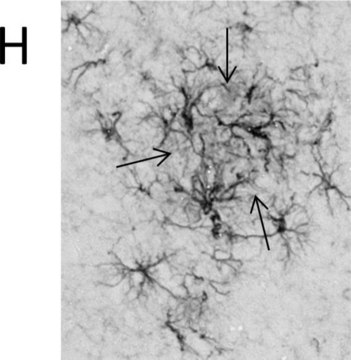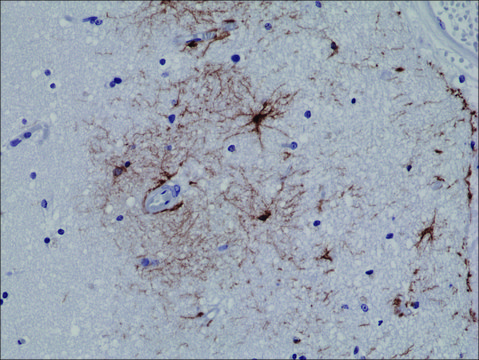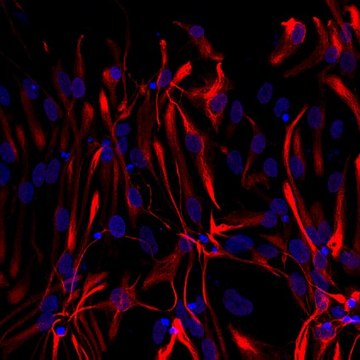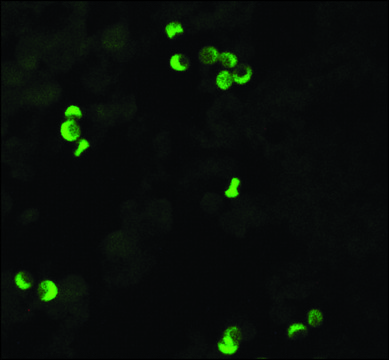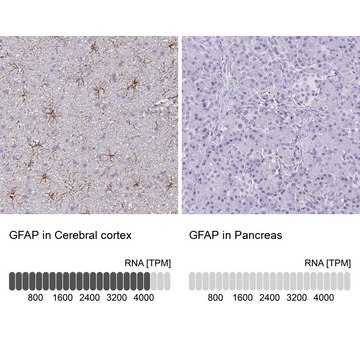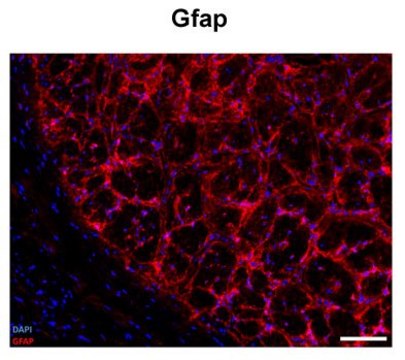推荐产品
产品名称
Anti-GFAP antibody, Rabbit monoclonal, recombinant, expressed in proprietary host, clone SP78, affinity isolated antibody
生物来源
rabbit
质量水平
重组
expressed in proprietary host
偶联物
unconjugated
抗体形式
affinity isolated antibody
抗体产品类型
primary antibodies
克隆
SP78, monoclonal
种属反应性
human (tested)
种属反应性(根据同源性预测)
mouse, bovine, dog, rabbit, pig, rat
技术
immunohistochemistry: 1:100
同位素/亚型
IgG
UniProt登记号
运输
wet ice
储存温度
2-8°C
靶向翻译后修饰
unmodified
基因信息
human ... GFAP(2670)
一般描述
Glial fibrillary acidic protein (GFAP) is a member of the class III intermediate filament protein family. It is heavily, and specifically, expressed in astrocytes and certain other astroglia in the central nervous system, in satellite cells in peripheral ganglia, and in non myelinating Schwann cells in peripheral nerves. In addition, neural stem cells frequently strongly express GFAP. Antibodies to GFAP are therefore very useful as markers of astrocytic cells. In addition, many types of brain tumors presumably derived from astrocytic cells, heavily express GFAP. GFAP is also found in the lens epithelium, Kupffer cells of the liver, in some cells in salivary tumors and has been reported in erythrocytes. GFAP is particular expressed in auricular chondrocytes.
免疫原
Synthetic peptide corresponding to C-terminus of human GFAP protein.
应用
Anti-GFAP antibody, Rabbit monoclonal has been used in immunocytochemistry and Immunohistochemistry.
生化/生理作用
Glial fibrillary acidic protein (GFAP) maintains the structure and motility of astrocytes. Gfap mediates the interaction between neurons and glial cells. It is responsible for the integrity and function of blood-brain barrier. Myelination and brain injury induced astrogliosis is controlled by Gfap. Cytoskeleton disintegration is known to stimulate the release of Gfap. Upregulation of this gene is observed in traumatic brain injury such as intracerebral hemorrhage and thus serves as a biomarker. Mutation in the GFAP gene causes Alexander disease.
特点和优势
Evaluate our antibodies with complete peace of mind. If the antibody does not perform in your application, we will issue a full credit or replacement antibody. Learn more.
外形
0.1 ml rabbit monoclonal antibody purified by protein A/G in PBS/1% BSA buffer pH 7.6 with less than 0.1% sodium azide.
免责声明
Unless otherwise stated in our catalog or other company documentation accompanying the product(s), our products are intended for research use only and are not to be used for any other purpose, which includes but is not limited to, unauthorized commercial uses, in vitro diagnostic uses, ex vivo or in vivo therapeutic uses or any type of consumption or application to humans or animals.
未找到合适的产品?
试试我们的产品选型工具.
储存分类代码
10 - Combustible liquids
WGK
WGK 2
闪点(°F)
Not applicable
闪点(°C)
Not applicable
法规信息
含少量动物源组分生物产品
常规特殊物品
Increases of Plasma Levels of Glial Fibrillary Acidic Protein, Tau, and Amyloid β up to 90 Days after Traumatic Brain Injury.
Tanya B, et al.
Journal of Neurotrauma, 34(1), 66?73-66?73 (2017)
Time-dependent activity of Na+/H+ exchanger isoform 1 and homeostasis of intracellular pH in astrocytes exposed to CoCl2 treatment.
Wang P, et al.
Molecular Medicine Reports, 13(5), 4443-4450 (2016)
The predominant neural stem cell isolated from postnatal and adult forebrain but not early embryonic forebrain expresses GFAP.
Imura T, et al.
The Journal of Neuroscience, 23(7), 2824-2832 (2003)
The Human Intermediate Filament Database: comprehensive information on a gene family involved in many human diseases.
Szeverenyi I, et al.
Human Mutation, 29(3), 351-360 (2008)
Biological roles of glial fibrillary acidic protein as a biomarker in cartilage regenerative medicine.
Kanazawa S, et al.
Journal of Cellular Physiology, 232(11), 3182-3193 (2017)
我们的科学家团队拥有各种研究领域经验,包括生命科学、材料科学、化学合成、色谱、分析及许多其他领域.
联系技术服务部门